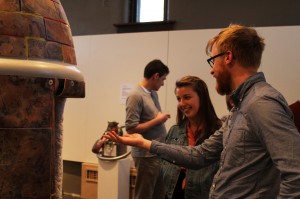By Lee Purvey
purveyle@grinnell.edu
What if you thought about art as a cocktail? This rather novel question drives the vast majority of the works in the Layers of Containment: Cat Castles & Curated Cocktails sculpture exhibition, which opened Thursday evening at the Grinnell Art Gallery on 926 Broad Street and will run through April 26.
The show, which is collaboratively curated by Joe Lacina, 27, and Mustafa Hammouda, 26, long-time friends who grew up together in Grinnell, is composed of sculptures combining everyday objects into meaningful wholes, which, through symbolism and juxtaposition, comment on a slew of contemporary issues.
“[We’re] taking discrete objects that are familiar in their own right and making them novel and fresh again by their combination and application,” Hammouda said.
The “Curated Cocktails” that ring the gallery and comprise the bulk of the exhibition resulted, in part, from Hammouda’s experience working as mixologist for the local restaurant Relish. While Lacina, who studied at the Maryland Institute College of Art and currently serves as Co-Director of the Grin City Collective artist community north of Grinnell, began planning the exhibition as a solo project about a month ago, Hammouda soon got on board when he suggested the idea of approaching the exhibition as one would a menu of mixed drinks.
“I remember there being a point where [Lacina] didn’t really know what [he was] going to do yet,” Hammouda said. “And I was like, ‘Yo, I would totally create new drinks for any piece of art that you put up and put in a show.’”
From there, it was only a short step to creating art pieces that represented the craft of mixology themselves.
The pair’s first “cocktail” was to be called the Fiscal Cliff.
“It’s like a shot of Balvenie and a shot of Patrón. Pour it down the sink after charging $50 dollars and then mocking the customer,” Hammouda said.
Unfortunately, this piece didn’t make it into the show, due to its generally interactive nature.
“That one’s hard to show,” Lacina said. “It’s more of a performance.”
While the accompanying descriptions of the works display the names of several other individuals, Lacina and Hammouda admit that they made these “artists” up—part of the exhibition’s larger comment on authorship and art in the digital age.
“If someone asks, we’ll tell them. But I think a lot of people don’t ask and they sort of flow through the exhibition and make assumptions about the art and about the artists,” Lacina said. “It’s bringing authorship into question, especially with things like the internet. Most art is digested through JPEGs and everyone’s just [experiencing] a flush of endless images and art. … It’s more of like we’re a blogger and we’re just sort of re-blogging these art objects.”
Hammouda presented a slightly different rationale.
“Mostly, I’m just hoping to use them to shift blame when angry people start talking to me,” he said.

The “cocktails” themselves—altar-like creations, each incorporating some sort of receptacle and liquid—are made of a diverse array of objects that the artists picked up at various locations around town or ordered off of the internet, from circuit boards to a pet water bottle to a 200-pound cube of compressed aluminum, on loan from the local junkyard.
“We’re using a lot of found objects,” Lacina said. “A lot of readymades.”
One piece, MASS EFFECT II (all works are named after video games), attributed to one “Peter Rainbott,” seems to comment on the increasing demands for productivity facing Americans in a modern world. A series of Kum & Go-brand Nuclear Energy Shots are connected by wires to some kind of filtration device that in turn runs into a large coffee-mug.
The accompanying descriptions offer the visitor a chance to engage with the seemingly mundane objects on a more symbolic level. Another cocktail, CRYSIS 2—which involves a wireless router, a glass of a red crystallized semi-liquid and a set of bullets, among other materials—is accompanied by a recipe of sorts.
“Mix 4 parts base human emotion with 1 part cold war hysteria, muddle briefly (or not bro). Infuse for 50 years,” the plaque reads.
Occupying the center of the gallery space is the titular Cat Castle, an interactive structure covered in a skin of linoleum squares. Visitors are able to enter the darkened chamber and gaze into a further compartment, where they are met by nature sounds and a dim light. For the artists, this piece addresses the material excess that pervades an American society plagued by social inequalities.
“It’s about consumerism—buying a castle for your cat,” Lacina said. “The absurdity of our current situation; some are privileged and some are starving. And Cat Castle is kind of a symbol of that.”
“There are pets with insurance in America and we don’t have universal healthcare,” Hammouda added.
The gallery will be open Monday through Friday from 2:30-5:30 p.m. and Saturdays from 9:00 a.m.-12:00 p.m.


















































